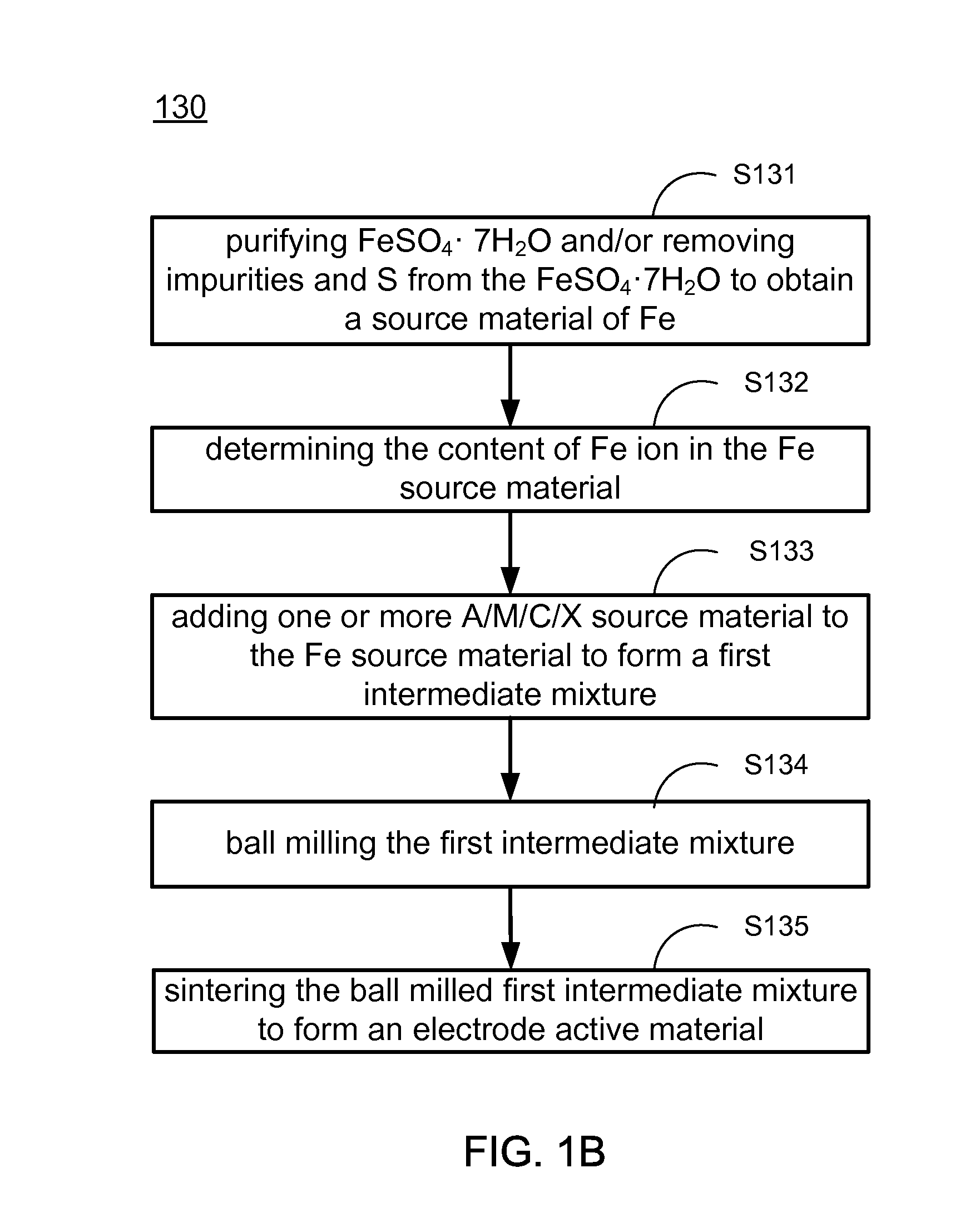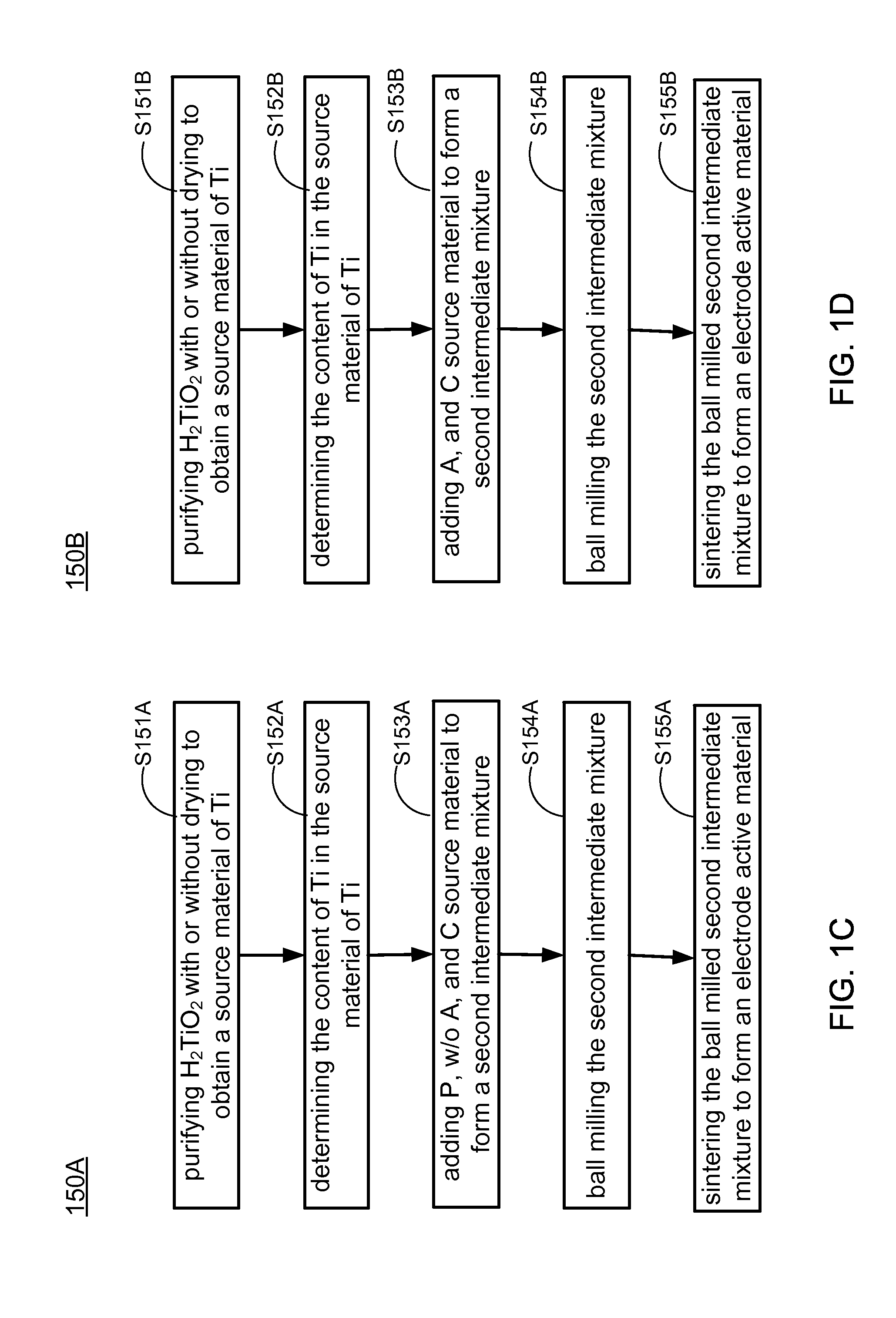Methods of making low cost electrode active materials for secondary batteries from ilmenite
a technology of active materials and secondary batteries, which is applied in sustainable manufacturing/processing, cell components, alkali titanates, etc., can solve the problems of low density and low cycle life of batteries available for grid-level storage, sulfation, and significant negative impact on the environmen
- Summary
- Abstract
- Description
- Claims
- Application Information
AI Technical Summary
Benefits of technology
Problems solved by technology
Method used
Image
Examples
example 1
Producing LiFePO4 from Source Material of Fe
[0145]In one embodiment, the electrode active composite material is LiFePO4. Referring to FIG. 1B, to make LiFePO4, the purified FeSO4 is dissolved in water to form a solution. Hydrogen peroxide (H2O2) is added to the solution, such that the Fe2+ in the solution is substantially completely oxidized to Fe3+. Then at least one phosphoric acid or phosphate, such as H3PO4, NH4H2PO4, (NH4)2HPO4, NaH2PO4, Na2HPO4, is added to the solution. The molar ratio of the phosphorus in the phosphoric acid or phosphate to the Fe3+ in the solution is P / Fe=1.0-1.2. After adding the at least one phosphoric acid or phosphate, the pH of the solution is adjusted by, for example, ammonium hydroxide, sodium hydroxide, sodium carbonate, or sodium bicarbonate, to about pH 1.0-3.5, such that iron phosphate (FePO4) is precipitated from the solution. The FePO4 may be further washed to remove impurities, such as sulfur or sodium, to form the source material of Fe. A sou...
example 2
Producing LiFexV(1-x)PO4 from Source Material of Fe
[0146]In one embodiment, the electrode active composite material is LiFexV(1-x)PO4. Referring to FIG. 1B, to make LiFexV(1-x)PO4, the purified FeSO4 is dissolved in water to form a solution. H2O2 is added to the solution, such that the Fe2+ in the solution is substantially completely oxidized to Fe3+. In one embodiment, the added H2O2 is a solution of about 27% of H2O2 in water. Then at least one phosphoric acid or phosphate is added to the solution. The molar ratio of the phosphorus in the added phosphoric acid or phosphate to the Fe3+ in the solution is P / Fe=1.0-1.2. After adding the at least one phosphoric acid or phosphate, the pH of the solution is adjusted by, for example, ammonium hydroxide, sodium hydroxide, sodium carbonate, or sodium bicarbonate, to about pH 1.0-3.5, such that FePO4 is precipitated from the solution. The FePO4 may be further washed to remove impurities, such as sulfur or sodium, to form the source material...
example 3
Producing LiFePO4 From Source Material of Fe
[0147]In one embodiment, the electrode active composite material is LiFePO4. Referring to FIG. 1B, to make LiFePO4, the purified FeSO4 crystals are dissolved in water to form a solution. Then at least one phosphoric acid or phosphate is added to the solution. The molar ratio of the phosphorus in the phosphoric acid or phosphate to the Fe ion in the solution is P / Fe=1.4-1.6. After adding the at least one phosphoric acid or phosphate, the pH of the solution is adjusted by, for example, ammonium hydroxide, sodium hydroxide, sodium carbonate, or sodium bicarbonate, to about pH 3.5-6.5, such that iron (II) phosphate (Fe3(PO4)2) is precipitated from the solution. The Fe3(PO4)2 may be further washed to remove impurities, such as sulfur or sodium, to form the source material of Fe. A source material of Li and a source material of phosphorus (P) according to predetermined Li / Fe / P molar ratio, and a certain amount of source material of C are added t...
PUM
| Property | Measurement | Unit |
|---|---|---|
| molar ratio | aaaaa | aaaaa |
| molar ratio | aaaaa | aaaaa |
| time | aaaaa | aaaaa |
Abstract
Description
Claims
Application Information
 Login to View More
Login to View More - R&D
- Intellectual Property
- Life Sciences
- Materials
- Tech Scout
- Unparalleled Data Quality
- Higher Quality Content
- 60% Fewer Hallucinations
Browse by: Latest US Patents, China's latest patents, Technical Efficacy Thesaurus, Application Domain, Technology Topic, Popular Technical Reports.
© 2025 PatSnap. All rights reserved.Legal|Privacy policy|Modern Slavery Act Transparency Statement|Sitemap|About US| Contact US: help@patsnap.com



